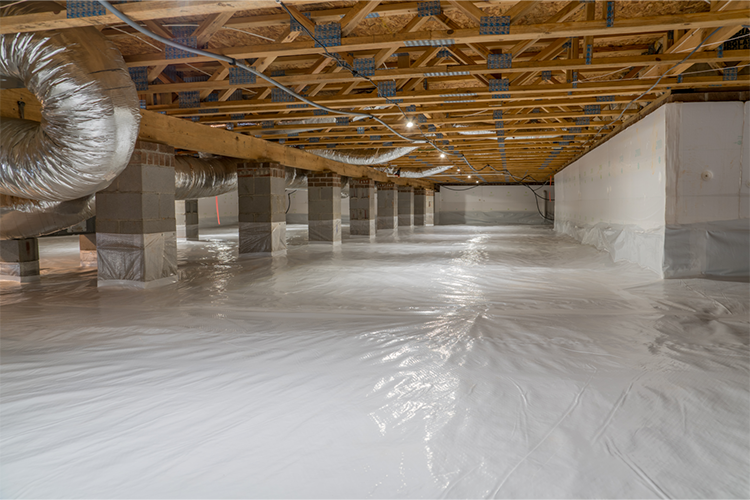What is your favorite part about summer in Virginia?
Maybe it’s the backyard barbeques, weekends by the pool, or long, sunny days to get outside and enjoy nature. There’s a lot to love about summertime — but one part that is unlikely to be anyone’s favorite is the humidity.
Humidity can sap your energy and make even short walks uncomfortable. And while it’s unpleasant for humans, it’s downright hazardous to the health of your crawlspace.
Humid conditions can wreak havoc on the crawlspaces of Virginia homes by creating the perfect conditions for mold, mildew, and destructive pests to thrive. In this post, we’ll cover the factors contributing to crawl space mold and mildew, the signs you might have a problem with, and what to do about it.
Keep reading for our top tips on how to beat the humidity and prevent mold in your crawl space.
What Causes Mold and Mildew Under a House?
Mold and mildew thrive in damp, dark environments. That means your humid, untreated crawlspace is a prime spot for mold to run rampant. Here’s why:
- Humidity: High humidity levels in your crawl space are the number one cause of mold growth. Warm, moist air can easily seep into the crawl space, especially during the humid months. Once inside, the moisture gets trapped and creates an ideal environment for mold spores to grow and spread.
- Drainage: If your home has poor drainage, water will likely pool near the foundation and seep into your crawl space. Whether it’s from heavy rainfall, a high water table, or improperly directed gutters, excess water nearly always equals mold if your crawl space is treated.
- Improper Ventilation: Crawl spaces that are not properly ventilated can trap moisture inside. Without a way to control moist air under your house, the space remains damp, giving mold the perfect conditions to thrive. Even during cooler months, improper ventilation can lead to condensation and contribute to mold growth.
- Leaky Pipes: Leaky pipes are another common source of moisture in crawl spaces. Whether it’s a slow drip from a water line or condensation on cold pipes, any additional moisture in the area increases the risk of mold. Over time, even a small leak can cause significant problems if left unaddressed.
Signs Your Crawl Space Has Mold Issues
No one wants black mold under their house. If your crawl space does have mold, then finding and addressing it early can save you time, money, stress, and even your health. Here’s what to look for before mold problems get out of hand.
- Common Signs: Musty odors, visible mold growth, and water stains are all telltale signs of mold in your crawl space. Mold spores can also infiltrate the air in the rest of your house. You may even notice increased allergy symptoms or respiratory issues for yourself, your kids, or even your pets.
- Getting an Inspection: If you suspect mold but aren’t sure, it’s wise to get a professional inspection. Crawl space professionals can quickly and accurately assess the condition of your crawl space, identify the extent of the problem, and recommend the best course of action. As an added benefit, many crawl space companies— like Crawl Space Care —offer free, no-obligation inspections!
How to Prevent and Get Rid of Crawl Space Mold
If your crawl space is untreated, chances are it’s not mold-free. An assessment can identify mold and gauge its severity. The best way to kill mold in a crawl space and prevent it from coming back is with professional crawl space services. Armed with the right information, a crawl space professional can undertake a range of services from crawl space mold treatment and more, including:
- Vapor Barriers: installing a vapor barrier is one of the most effective ways to prevent moisture from entering your crawl space. This heavy-duty plastic sheeting covers the ground and walls, blocking moisture from the soil and reducing humidity levels.
- Dehumidifiers: a dehumidifier designed for crawl spaces can help maintain optimal humidity levels, especially in areas with naturally high humidity. These units are powerful enough to keep the air dry, preventing mold growth.
- Encapsulation: crawl space encapsulation involves sealing off your crawl space entirely from the outside environment. This process includes installing vapor barriers, insulating the walls, and sometimes adding a dehumidifier. Encapsulation creates a controlled environment, dramatically reducing the risk of mold and mildew.
When to Hire Crawl Space Specialists
While some homeowners may feel comfortable tackling mold prevention on their own, certain situations require professional help. If your crawl space has significant moisture issues, structural concerns, or a history of mold, it’s best to call in specialists. They have the expertise and equipment to address the problem comprehensively and ensure your home remains safe and dry.
Mold in your crawl space is not something to ignore. Luckily, Crawl Space Care is standing by to help! Our professionals, located in Roanoke, VA, and the surrounding areas, can tackle the entire area to turn your dank, musty crawl space into a clean, dry space. You’ll enjoy better energy efficiency, air quality, less pests, and more peace of mind.
Contact us today for your free inspection and hassle-free estimate.


